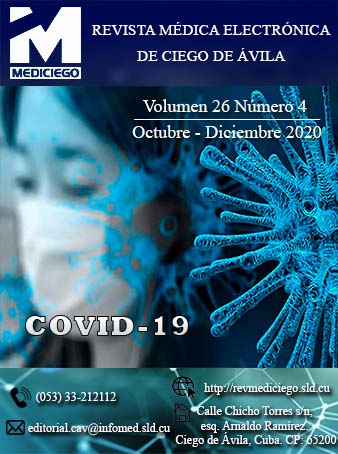La depresión como consecuencia del acoso psicológico laboral
Resumen
Introducción: el acoso psicológico o la intimidación en el trabajo es causa frecuente de estrés laboral y otros riesgos para la salud de los trabajadores, y puede ocasionar problemas físicos, psicológicos y trastornos emocionales, entre ellos la depresión.
Objetivo: describir las características que identifican el acoso psicológico y la presencia de depresión en el entorno laboral.
Métodos: se realizó una revisión bibliográfica y para ello, se hicieron búsquedas en las bases de datos ClinicalKey, MEDLINE, LILACS, Cumed, DynaMed y el buscador Google académico, entre los años 2016 y 2020, en idioma español e inglés.
Desarrollo: el acoso psicológico es un problema de violencia y hostigamiento en el mundo laboral. Diversos autores coinciden en definirlo como el acoso psicológico o moral que ejerce una o varias personas sobre otras a través de maltrato, menosprecio, humillación, burla y sarcasmos, que busca el aniquilamiento psicológico y el derrumbe moral de la víctima con el fin de eliminarla del medio laboral. Es un proceso compuesto por una serie de actuaciones hostiles que, tomadas de forma aislada, podrían parecer anodinas, pero cuya repetición constante tiene efectos perniciosos sobre la salud. La consecuencia psicológica más común es la presencia de un episodio depresivo mayor, o el estado de distimia, que puede llegar al suicidio.
Conclusiones: la depresión es un trastorno emocional muy relacionado con los factores estresantes que incluyen el ámbito laboral. Su identificación temprana ante la presencia del acoso psicológico laboral favorece el tratamiento oportuno y mejora la calidad de vida de los trabajadores
Descargas
Publicado
Cómo citar
Número
Sección
Licencia
Derechos de autor 2021 María Luisa Ellis Yard, Marleny Abreu Terry, Milagros Sánchez Sarduy

Esta obra está bajo una licencia internacional Creative Commons Atribución-NoComercial 4.0.
Aquellos autores/as que tengan publicaciones con esta revista, aceptan los términos siguientes de la Licencia CC Attribution 4.0/ International/ Deed (CC BY 4.0):
Usted es libre de:
- Compartir — copiar y redistribuir el material en cualquier medio o formato para cualquier propósito, incluso comercialmente.
- Adaptar — remezclar, transformar y construir a partir del material para cualquier propósito, incluso comercialmente.
La licenciante no puede revocar estas libertades en tanto usted siga los términos de la licencia
Bajo las condiciones siguientes:
- Atribución — Usted debe dar crédito de manera adecuada , brindar un enlace a la licencia, e indicar si se han realizado cambios . Puede hacerlo en cualquier forma razonable, pero no de forma tal que sugiera que usted o su uso tienen el apoyo de la licenciante.
- No hay restricciones adicionales — No puede aplicar términos legales ni medidas tecnológicas que restrinjan legalmente a otras a hacer cualquier uso permitido por la licencia.
La revista no se responsabiliza con las opiniones y conceptos emitidos en los trabajos, son de exclusiva responsabilidad de los autores. El Editor, con la asistencia del Comité de Editorial, se reserva el derecho de sugerir o solicitar modificaciones aconsejables o necesarias. Son aceptados para publicar trabajos científico originales, resultados de investigaciones de interés que no hayan sido publicados ni enviados a otra revista para ese mismo fin.
La mención de marcas comerciales de equipos, instrumentos o materiales específicos obedece a propósitos de identificación, no existiendo ningún compromiso promocional con relación a los mismos, ni por los autores ni por el editor.






















